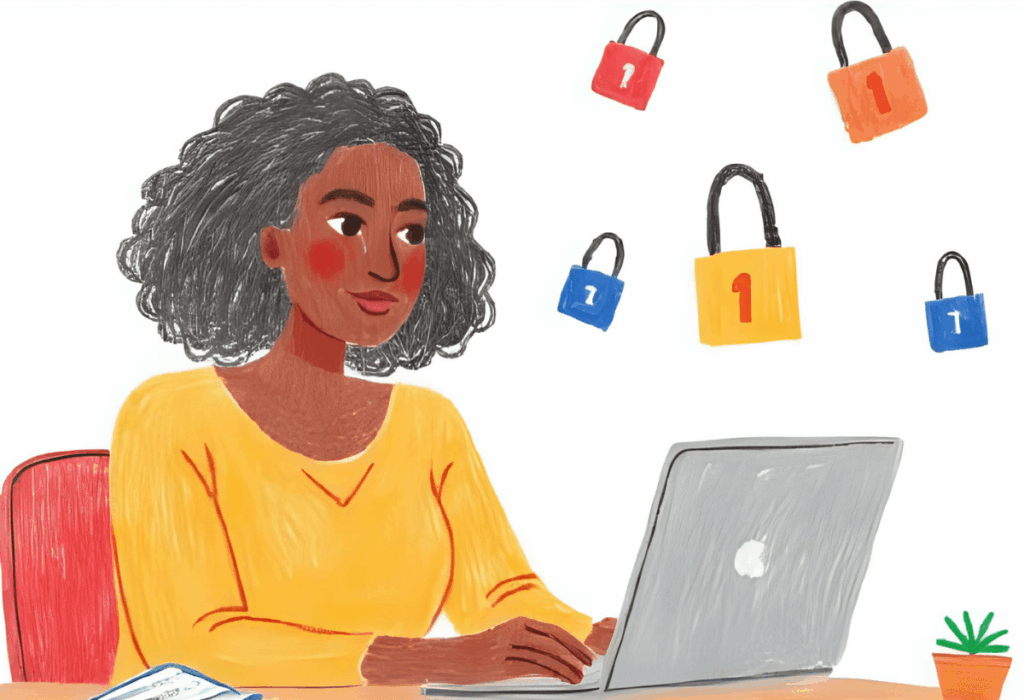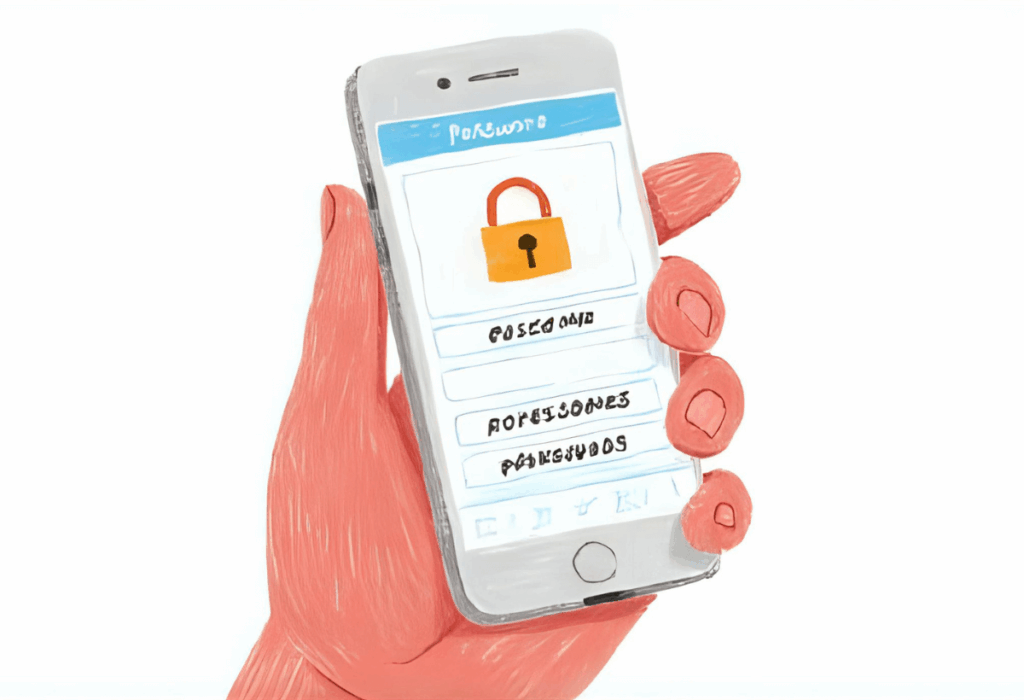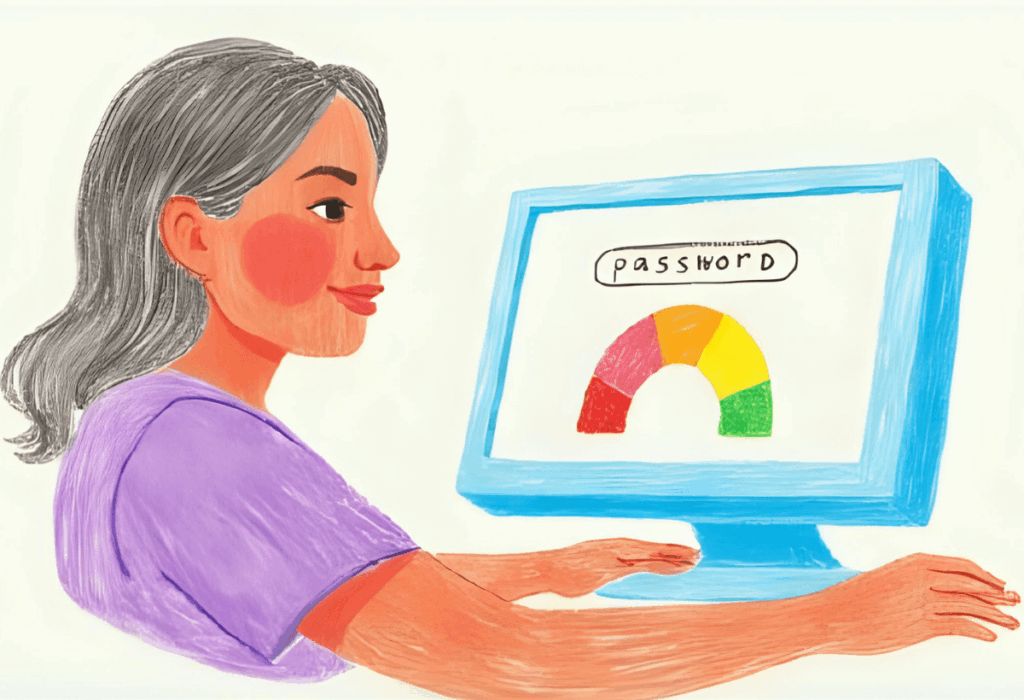In 2025, weak passwords remain the easiest way for hackers to access your accounts and even our identities. Despite decades of warnings about password security, most people still rely on simple passwords that can be cracked in seconds, putting their sensitive information at serious risk. Weak passwords are often the first to be hacked in cyberattacks, making them a prime target for anyone attempting to hack into your accounts.
The consequences of poor password choices extend far beyond just one account. When you reuse passwords across multiple accounts, a single data breach can compromise everything from your social media accounts to your important accounts containing financial information. Accounts are frequently hacked when weak or reused passwords are exploited by attackers, leading to widespread security breaches. This comprehensive guide will show you exactly how to create a strong password that protects your digital life.
You’ll learn the essential elements that make passwords virtually uncrackable. You’ll also discover proven techniques for creating memorable yet secure passwords, and how modern tools like password managers can revolutionize your approach to password security. Whether you’re protecting personal info or securing business accounts, these strategies will help you stay ahead of hackers in 2025.

Introduction to Password Security
Password security is the foundation of protecting your online accounts and sensitive information in today’s digital world. Every time you create an account, you’re trusting that a single password will safeguard your data, personal info, and even your identity from unauthorized access. That’s why it’s essential to use a strong password for every account you create.
A strong password should be at least 16 characters long and include a mix of uppercase and lowercase letters, numbers, and special characters. This combination makes it much harder for hackers to guess or crack your password using automated tools. Creating complex passwords for each account can seem overwhelming, but a password manager can make the process simple and secure. Password managers help you generate, store, and manage unique passwords for all your accounts, so you don’t have to remember each one.
By prioritizing password security and following best practices—like using a password manager, creating complex passwords, and never reusing the same password—you can protect your sensitive information and maintain control over your digital life. Taking these steps is the most effective way to prevent data breaches and keep your accounts secure.
Essential Elements of a Strong Password
A strong password serves as your first line of defense against unauthorized access to your accounts. To create a strong password that can withstand modern hacking attempts, you need to understand the core elements that make passwords secure.
Length is your strongest weapon. Use at least 16 characters for maximum security, though 8 characters represents the absolute minimum acceptable length. Each additional character exponentially increases the time needed for hackers to crack your password. A 16-character password could take over 500 years to crack using current brute-force technology, while an 8-character password might fall in just minutes.
Character variety adds complexity. Include all four character types in your passwords:
- Uppercase letters (A, B, C, D, E)
- Lowercase letters (x, y, z, a, b)
- Numbers (7, 3, 9, 1, 5)
- Special characters (@, #, $, !, %)
Uniqueness protects all your accounts. Create unique passwords for every single account you own. This means your email password should be completely different from your banking password, which should be different from your social media accounts password. When you use the same password across multiple accounts, hackers can access everything with just one successful breach.
Avoid predictable patterns. Strong passwords don’t follow dictionary words, personal information, or common substitution patterns. Instead of “Password123!”, which follows a predictable pattern, use something like “M0l#eb9Qv?” or “9Sp!dErscalKetobogGaN” that appears random to both humans and computer programs.
The key to maintaining strong passwords across all your accounts lies in understanding that password strength depends more on unpredictability and length than on complex rules that make passwords hard to remember but easy for computers to guess.
Password Length and Complexity Requirements
Understanding why longer passwords provide exponentially better security helps explain why modern password guidelines have shifted away from complex passwords toward long passwords. The mathematics behind password security reveals why adding just a few extra characters can mean the difference between seconds and centuries for password cracking.
The exponential advantage of length. When hackers use automated tools to guess passwords, they must try every possible combination until they find the right one. An 8-character password using only lowercase letters gives hackers 26^8 possible combinations (approximately 208 billion). A 16-character password using the same character set provides 26^16 combinations (approximately 43 sextillion) – that’s over 200 billion times more secure.
Real-world crack times demonstrate the difference. Security researchers have calculated that with current hardware capable of 100 billion password guesses per second:
- 8-character simple passwords: Minutes to hours
- 12-character mixed passwords: Several years
- 16-character mixed passwords: Multiple centuries
- 20-character passphrases: Effectively uncrackable with current technology
Character combinations multiply security. When you combine uppercase letters (26 options), lowercase letters (26 options), numbers (10 options), and symbols (32 common options), you create a character space of 94 possible choices per position. This means a 16-character password using all character types offers 94^16 possible combinations.
Here are concrete examples of how character combinations strengthen passwords:
- Weak: “johnsmith” (9 characters, lowercase only)
- Better: “JohnSmith2024” (13 characters, mixed case and numbers)
- Strong: “J0hn$m!th2024#Qx” (16 characters, all character types)
- Strongest: “Elephant82!Bicycle#Tornado94$Coffee” (34 characters, passphrase with symbols)
How hackers attack passwords. Understanding hacker methods helps explain why length matters more than complexity. Hackers use several approaches:
- Dictionary attacks: Testing common passwords and words
- Brute force attacks: Systematically trying every combination
- Pattern attacks: Exploiting predictable character substitutions
Long passwords with random characters defeat all these methods because they can’t be found in dictionaries, take too long to brute force, and don’t follow predictable patterns.

What Never to Include in Your Passwords
Creating secure passwords requires knowing what to avoid just as much as knowing what to include. Many people unknowingly use information that makes their passwords vulnerable to targeted attacks and social engineering.
Personal Information to Avoid
Never use dates and numbers connected to your life. Birth years, birth months, birth dates, and anniversary dates are easily discovered through social media profiles, public records, or simple observation. Hackers often start with these obvious choices when attempting to access accounts.
Avoid these personal identifiers in any password:
- Your name, spouse’s name, or family members’ names
- Pet names, even if they seem obscure to you
- Your address, street name, city, or neighborhood
- Phone numbers, including area codes or partial numbers
- Social Security numbers or other identification numbers
- Employer names, job titles, or workplace-related terms
Social media reveals too much. Information you share online becomes ammunition for hackers. Your hobby-related words, favorite sports teams, vacation destinations, or interests visible on your social profiles should never appear in passwords. Even if you think a reference is subtle, automated tools can scrape your online presence for password hints.
Don’t use location-based information. Your current city, hometown, school names, or geographic references make passwords predictable. Hackers can easily research this information and include it in targeted attacks against your accounts.
Common Password Patterns to Avoid
Sequential patterns are hacker favorites. Avoid any sequence that follows a predictable order:
- Number sequences: 1234, 5678, 0000, 1111, 2468, 1357
- Letter sequences: qwerty, abcd, asdf, keyboard patterns
- Ascending/descending patterns: 9876543210, abcdefgh
Dictionary words in any language remain vulnerable. Modern password-cracking software includes dictionaries for multiple languages, common phrases, and popular culture references. This means passwords like “butterfly,” “mariposa,” or “papillon” (butterfly in Spanish and French) are all equally weak.
Simple substitutions fool no one. Common character substitutions like @ for A, 3 for E, 0 for O, or $ for S don’t significantly improve security if used for single words. Passwords like “P@ssw0rd,” “Tr0ub4dor&3,” or “M0nk3y$” follow patterns that cracking software easily recognizes.
Avoid popular culture references. Movie quotes, song lyrics, book titles, TV show references, or celebrity names appear in password dictionaries. Even with modifications, phrases like “MayTheForce,” “WinterIsComing,” or “ToInfinityAndBeyond” remain vulnerable to attacks.
Don’t use repeated characters or simple patterns. Passwords like “aaaaaa,” “123abc,” “password123,” or “qwerty123” follow predictable patterns that offer no real security despite seeming different from each other.
The goal is to create passwords that have no logical connection to your life or predictable patterns that automated tools can exploit.
Proven Techniques for Creating Strong Passwords
Learning reliable methods to create a strong password ensures you can generate secure credentials that are both memorable and practically uncrackable. Strong passwords can be created using manual techniques or with the help of a password generator, which produces randomized passwords based on your chosen parameters. These techniques balance security with usability, making it easier to maintain strong passwords across all your accounts.
The Passphrase Method
Combine unrelated words for maximum security. Choose 3-4 completely unrelated longer words that have no logical connection to each other or your life. The randomness of word selection makes the password unpredictable while the length makes it virtually impossible to crack.
Start with random words like “elephant bicycle tornado coffee” and transform them into a strong password by adding numbers and symbols between words. Your final password becomes “Elephant82!Bicycle#Tornado94$Coffee” – a 34-character powerhouse that would take trillions of years to crack.
Select words strategically. Choose words that:
- Have no connection to your personal life
- Aren’t commonly used together in phrases
- Include different parts of speech (nouns, adjectives, verbs)
- Avoid seasonal or temporal references
Make each word unique. Ensure the words you combine don’t tell a story or create logical connections. “Car garage mechanic tools” tells a story, making it potentially guessable. “Cactus penguin telescope cookies” provides no logical pattern for hackers to exploit.
The Sentence Method
Transform memorable sentences into complex passwords. Create a sentence that’s meaningful to you, then use the first letter of each word along with numbers and symbols to build your password. This technique creates random password combinations while maintaining memorability.
For example: “My favorite pizza has 8 toppings and costs $15 in downtown” becomes “MfpH8tAc$15Id!” This method produces a 13-character password with all character types while being relatively easy to remember.
Create account-specific variations. Modify your base sentence for different accounts to ensure uniqueness:
- Banking: “My bank account protects $5000 with strong security daily” → “MbaP$5wsSD!”
- Email: “I check my email 3 times per day for work” → “IcmE3tPdFw!”
- Social media: “I post pictures 2 times weekly on social media” → “IpP2tWoSm!”
Deliberate Misspelling Technique
Replace letters strategically with numbers and symbols. Take a base phrase and deliberately misspell words while substituting similar-looking characters. “Patio garden sunny day” becomes “P8tio0G#5dn$unNyday” through intentional character replacement.
Common effective substitutions include:
- Replace O with 0 (zero)
- Replace E with 3
- Replace A with @
- Replace I with !
- Replace S with $
- Replace T with 7
Combine multiple substitution methods. Layer different techniques within the same password to increase complexity. Start with misspelled words, add character substitutions, then include random numbers and symbols. This approach creates passwords like “Tr@v3l!ng7o8M@r$” from “traveling to Mars.”
Maintain partial readability. The key is making substitutions that you can remember while ensuring the result doesn’t appear in any dictionary. Your misspellings should be intentional and consistent rather than random, allowing you to recreate the password when needed.
These techniques help you create passwords that resist both dictionary attacks and brute force attempts while remaining manageable for regular use.

Tips for Remembering Passwords
Remembering multiple strong passwords doesn’t have to be a struggle. There are several effective strategies to help you keep track of your unique passwords without sacrificing security. One of the best methods is to use a passphrase—a sequence of random words that’s easy for you to remember but nearly impossible for others to guess. For example, a phrase like “BlueCarpet!Tiger7Window” combines words, numbers, and symbols for a strong password that’s memorable.
Another helpful tip is to use a combination of letters, numbers, and symbols in a pattern that makes sense to you. For instance, you might always capitalize the first letter of each word or use a specific symbol between words. Creating a consistent pattern can help you recall your passwords while still keeping them unique for each account.
Of course, the easiest and most secure way to remember your passwords is to use a password manager. A password manager can generate, store, and autofill strong passwords for all your accounts, so you only need to remember one master password. This not only improves your password security but also eliminates the temptation of reusing passwords or writing them down.
By using these tips—whether it’s a memorable passphrase, a personal pattern, or a trusted password manager—you can create and remember strong, unique passwords for every account, reducing the risk of forgetting or reusing passwords and keeping your accounts secure.
Using Password Managers for Maximum Security
Password managers revolutionize how you approach password security by removing the burden of remembering multiple passwords while ensuring every account has a unique password. These tools have become essential for maintaining strong passwords across the dozens or hundreds of accounts most people now manage.
Password managers generate and store unique passwords automatically. Instead of trying to remember dozens of different passwords, you only need to remember one master password. The password manager handles everything else – generating random passwords for new accounts, storing existing passwords securely, and automatically filling login forms when you visit sites.
Popular password managers offer comprehensive solutions. Many password managers provide excellent security and usability:
- 1Password: Premium features with family sharing options
- Bitwarden: Open-source with robust free and paid tiers
- LastPass: User-friendly interface with cross-device sync
- Built-in browser managers: Basic functionality in Chrome, Safari, Firefox
Most password managers work across all your devices. Whether you’re logging in from your phone, tablet, or computer, trusted password manager apps synchronize your stored passwords across platforms. This seamless integration means you can access your accounts securely from anywhere without remembering multiple passwords.
Free versions provide essential features for personal use. You don’t need to pay for password management to get started. Many password managers offer free versions that include:
- Unlimited password storage
- Automatic password generation
- Cross-device synchronization
- Basic security features
- Browser integration
Password managers dramatically improve security practices. Research shows that organizations using password managers see a 43% reduction in password reset requests, indicating that users find these tools more convenient than traditional password management. This improved usability leads to better security practices overall.
Avoid unsafe storage methods. Never store passwords in:
- Computer documents or text files
- Sticky notes around your workspace
- Unencrypted browser-saved passwords
- Email drafts or messages
- Shared documents or cloud storage
Your master password requires special attention. Since your master password protects all other passwords, make it a long passphrase using the techniques described earlier. Consider something like “Purple42!Elephants#Dance@Midnight77$” – long enough to be secure but memorable enough to type regularly.
Password generators create truly random passwords. Let your password manager create random characters combinations for each account. These generated passwords typically include 16-20 characters with full character variety, providing maximum security without any effort on your part.
The investment in learning to use a password manager pays enormous dividends in both security and convenience, making it easier to maintain strong passwords than to manage weak ones.

Multi-Factor Authentication and Additional Security
Strong passwords provide your first line of defense, but multi factor authentication adds crucial additional layers that protect your accounts even if your password is compromised. This combination approach recognizes that password security works best as part of a comprehensive protection strategy.
Enable multifactor authentication on all supported accounts. MFA requires something you know (your password) plus something you have (your phone) or something you are (your fingerprint). This means that even if hackers obtain your password through a data breach or other means, they still can’t access your accounts without the second factor.
Priority accounts for MFA include:
- Email accounts (which often serve as password reset destinations)
- Banking and financial accounts
- Social media accounts
- Work-related accounts
- Cloud storage accounts
- Important accounts containing sensitive information
Authentication apps provide better security than SMS. While SMS-based MFA offers some protection, authentication apps like Google Authenticator, Authy, or Microsoft Authenticator provide stronger security. These apps generate time-based codes that work even without cell service and can’t be intercepted through SIM swapping attacks.
Biometric authentication adds convenience and security. Set up fingerprint or facial recognition where available on your devices. These methods provide quick access while maintaining security, especially for frequently accessed accounts. Most modern smartphones, tablets, and laptops support biometric authentication for both device access and app-specific logins.
Hardware security keys offer maximum protection. For your highest-value accounts, consider hardware security keys like YubiKey or Google Titan. These physical devices provide the strongest form of MFA available and are particularly valuable for accounts containing financial information or sensitive business data.
Backup authentication methods prevent lockouts. Always set up multiple MFA methods for important accounts:
- Primary: Authentication app codes
- Backup: Recovery codes stored in your password manager
- Emergency: Trusted device or alternative phone number
Regular security reviews catch potential issues. Check your account security settings monthly:
- Review active sessions and log out unknown devices
- Monitor login alerts and notifications
- Update recovery information and backup contacts
- Remove access for unused apps and services
Balance security with usability. While maximum security might suggest enabling every possible protection, practical usability matters for consistent implementation. Choose security measures you’ll actually use regularly rather than creating barriers that encourage workarounds.
The goal is creating a security ecosystem where each element reinforces the others, making your accounts significantly harder to compromise while remaining manageable for daily use.
Device Security and Password Protection
Protecting your devices is just as important as creating strong passwords, because a compromised device can give hackers direct access to your accounts and sensitive information. Start by using strong passwords or passcodes to lock your devices, and enable multifactor authentication wherever possible to add an extra layer of security.
Keeping your operating system and all software up to date is crucial, as updates often include security patches that protect against new threats. Install a reputable antivirus program to defend against malware that could steal your stored passwords or monitor your activity. Avoid accessing sensitive information on public computers or unsecured public Wi-Fi networks, as these can expose your accounts to hackers.
A password manager can further enhance your device security by generating and storing unique passwords for each account, reducing the risk of password reuse and making it easier to manage multiple accounts securely. By combining strong passwords, multifactor authentication, and robust device security practices, you can significantly reduce the risk of unauthorized access and protect your sensitive information across all your devices.
Online Security Threats to Passwords
The online world is full of evolving threats that target your passwords and sensitive information. Phishing attacks, where hackers trick you into revealing your password through fake emails or websites, remain one of the most common dangers. Brute force attacks, which use automated tools to guess your password, and data breaches, where large numbers of passwords are stolen from compromised sites, also put your accounts at risk.
To protect yourself, always use unique passwords for each account and enable multifactor authentication whenever possible. This ensures that even if one password is compromised, your other accounts remain secure. Be cautious when accessing sensitive information on public Wi-Fi or shared computers, as these environments can be vulnerable to hacking and surveillance.
Regularly monitor your accounts for suspicious activity and update your passwords if you suspect any unauthorized access. By understanding the most common online security threats to passwords and taking proactive steps—like using strong, unique passwords and multifactor authentication—you can safeguard your digital identity and protect your sensitive information from cybercriminals.
National Cybersecurity Guidelines for Passwords
National cybersecurity guidelines stress the importance of creating and maintaining strong, unique passwords for every account you use. These guidelines recommend using a password manager to generate and securely store complex passwords, making it easier to manage multiple accounts without reusing passwords. Enabling multifactor authentication is also strongly advised, as it adds an extra layer of protection beyond just your password.
When creating passwords, use a combination of uppercase and lowercase letters, numbers, and special characters to ensure your passwords are complex and difficult to guess. Avoid using easily guessable information such as birthdays, pet names, or common words, as these can be exploited by hackers. Instead, focus on creating passwords that are long, random, and unique for each account.
Staying informed about the latest cybersecurity threats and regularly updating your password practices are key to maintaining strong password security. By following national cybersecurity guidelines—using a password manager, enabling multifactor authentication, and creating complex, unique passwords—you can protect your accounts and sensitive information from unauthorized access and keep your digital identity secure.
Password Maintenance and Best Practices
Maintaining strong passwords requires ongoing attention and smart practices that evolve with changing security landscapes and emerging threats. Effective password maintenance balances proactive security measures with practical usability considerations.
Change passwords immediately for suspected breaches. If you receive breach notifications, notice suspicious account activity, or suspect unauthorized access, change those passwords right away. Don’t wait to investigate further – immediate action prevents potential damage and limits exposure.
Update passwords after confirmed data breaches. When companies report data breaches affecting user credentials, change your password for that service and any other accounts where you might have reused passwords. Breach notification websites and your password manager’s security features can help you track which accounts need attention.
Don’t change passwords frequently unless necessary. Modern security guidelines from NIST discourage routine password changes unless there’s a specific security concern. Forced frequent changes often lead to weaker passwords as users make minimal modifications to existing passwords or choose simpler options to avoid forgetting new ones.
Regularly audit your passwords using security reports. Most password managers provide security dashboards that identify:
- Weak passwords that need strengthening
- Reused passwords across multiple accounts
- Old passwords that haven’t been changed in years
- Passwords found in known data breaches
Replace weak or reused passwords gradually. Rather than trying to update everything at once, systematically improve your password security over time. Start with your most important accounts and work through less critical accounts as time permits. When updating your accounts, create new passwords that are strong and unique, avoiding easily accessible personal information. This approach prevents overwhelming yourself while steadily improving your overall security posture.
Monitor accounts for suspicious activity. Enable security notifications and regularly review:
- Login alerts from unfamiliar locations or devices
- Account security dashboards showing recent activity
- Email notifications about password changes or security settings modifications
- Financial account statements for unauthorized transactions
Keep recovery information current. Update your account recovery options when your contact information changes:
- Backup email addresses
- Phone numbers for SMS verification
- Security questions and answers
- Trusted contacts for account recovery
Document your security practices. Maintain a simple record of your security approach:
- Which accounts use MFA and what type
- Password manager master password backup plan
- Emergency access procedures for family members
- Important account recovery information storage
Plan for emergency access. Consider how trusted family members might access critical accounts if needed. This might involve:
- Shared password manager access with appropriate permissions
- Emergency contact information with service providers
- Clear documentation of important account locations
- Legal arrangements for digital asset management
Stay informed about evolving threats. Password security continues evolving as hackers develop new techniques and security experts discover better protection methods. Follow reputable security news sources and update your practices as new recommendations emerge.
The goal is creating sustainable security practices that improve over time rather than requiring perfect implementation from the start. Consistent incremental improvements provide better long-term security than ambitious changes that become difficult to maintain.

Conclusion
Creating and maintaining strong passwords in 2025 requires a strategic approach that prioritizes length over complexity, uniqueness over memorability, and practical implementation over perfect security. The techniques outlined in this guide – from using 16+ character passphrases to leveraging password managers and enabling multifactor authentication – provide a comprehensive framework for protecting your digital life.
Remember that password security is not about creating one perfect password, but about implementing a system that makes all your accounts more secure. Start by using a password manager to generate unique passwords for your most important accounts, enable MFA wherever possible, and gradually replace weak or reused passwords throughout your digital presence.
Your password security is only as strong as your weakest password. Begin implementing these practices today by choosing a trusted password manager, creating a strong master password, and systematically updating your most critical accounts. The time invested in building strong password habits now will protect your sensitive information and accounts for years to come.
Take action immediately: audit your current passwords, install a password manager, and enable two-factor authentication on your email and banking accounts. These three steps alone will dramatically improve your security posture and provide the foundation for maintaining strong passwords across all your accounts.